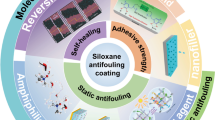Abstract
Various properties of composite materials were studied using Fourier-transform infrared (FTIR) spectral and Raman analysis techniques in this study. These two commonly used methods can quickly provide information about the analyzed materials. Hydroxypropyl methylcellulose (HPMC) has been widely used in anti-corrosion fields such as those related to foods and pharmaceuticals, and especially in the study of tribology-related issues. HPMC is derived from natural materials. However, as a biopolymer, the tribological capability of HPMC is limited. Therefore, biocompatible micro-particles with superior tribological properties, like MoS2, are added to enhance the tribological properties of film materials during application. FTIR spectral and Raman analyses were performed to investigate the characteristics of HPMC and HPMC/MoS2 composite materials, as well as their degradation behaviors in different solutions. The Raman spectral analysis also illustrated the good uniformity of the MoS2 distribution in thin films. Lastly, an X-ray diffraction (XRD) analysis confirmed the influence of the MoS2 addition on the crystallization and surface roughness of the thin films. This study demonstrated that the Raman, FTIR, and XRD techniques can rapidly provide important information about composite materials, making them suitable for in-process, real-time analyses.






Similar content being viewed by others
References
Bahadur, S.: The development of transfer layers and their role in polymer tribology. Wear 245(1), 92–99 (2000)
Bárcenas, M.E., Rosell, C.M.: Effect of HPMC addition on the microstructure, quality and aging of wheat bread. Food Hydrocoll. 19(6), 1037–1043 (2005). doi:10.1016/j.foodhyd.2005.01.005
Bhushan, B.: Principles and applications of tribology. Wiley, London (2013)
Brogly, M., Fahs, A., Bistac, S.: Surface properties of new-cellulose based polymer coatings for oral drug delivery systems. Polym. Prepr. 52, 1054 (2011)
De Veij, M., Vandenabeele, P., De Beer, T., Remon, J.P., Moens, L.: Reference database of Raman spectra of pharmaceutical excipients. J. Raman Spectrosc. 40(3), 297–307 (2009)
Ding, C., Zhang, M., Li, G.: Preparation and characterization of collagen/hydroxypropyl methylcellulose (HPMC) blend film. Carbohydr. Polym. 119, 194–201 (2015)
Ehrich, W., Höh, H., Kreiner, C.: Biocompatibility and pharmacokinetics of hydroxypropyl methylcellulose (HPMC) in the anterior chamber of the rabbit eye. Klin. Monatsbl. Augenheilkd. 196(6), 470–474 (1990)
Gierlinger, N., Schwanninger, M.: Chemical imaging of poplar wood cell walls by confocal Raman microscopy. Plant Physiol. 140(4), 1246–1254 (2006)
Holmberg, K.: A concept for friction mechanisms of coated surfaces. Surf. Coat. Technol. 56(1), 1–10 (1992)
Li, H., Zhang, Q., Yap, C.C.R., Tay, B.K., Edwin, T.H.T., Olivier, A., Baillargeat, D.: From bulk to monolayer MoS2: evolution of Raman scattering. Adv. Funct. Mater. 22(7), 1385–1390 (2012)
Liang, C., Marchessault, R.: Infrared spectra of crystalline polysaccharides. I. Hydrogen bonds in native celluloses. J. Polym. Sci. 37(132), 385–395 (1959a)
Liang, C.Y., Marchessault, R.H.: Infrared spectra of crystalline polysaccharides. II. Native celluloses in the region from 640 to 1700 cm−1. J. Polym. Sci. 39(135), 269–278 (1959b)
Moshkovith, A., Perfiliev, V., Lapsker, I., Fleischer, N., Tenne, R., Rapoport, L.: Friction of fullerene-like WS2 nanoparticles: effect of agglomeration. Tribol. Lett. 24(3), 225–228 (2006). doi:10.1007/s11249-006-9124-6
Myshkin, N., Petrokovets, M., Kovalev, A.: Tribology of polymers: adhesion, friction, wear, and mass-transfer. Tribol. Int. 38(11), 910–921 (2006)
Normand, V., Pudney, P.D., Aymard, P., Norton, I.T.: Weighted-average isostrain and isostress model to describe the kinetic evolution of the mechanical properties of a composite gel: application to the system gelatin: maltodextrin. J. Appl. Polym. Sci. 77(7), 1465–1477 (2000)
Proniewicz, L.M., Paluszkiewicz, C., Wesełucha-Birczyńska, A., Majcherczyk, H., Barański, A., Konieczna, A.: FT-IR and FT-Raman study of hydrothermally degradated cellulose. J. Mol. Struct. 596(1), 163–169 (2001)
Santha, N., Sudha, K., Vijayakumari, K., Nayar, V., Moorthy, S.: Raman and infrared spectra of starch samples of sweet potato and cassava. J. Chem. Sci. 102(5), 705–712 (1990)
Shi, S.-C., Huang, T.-F., Wu, J.-Y.: Preparation and tribological study of biodegradable lubrication films on Si substrate. Materials 8(4), 1738–1751 (2015)
Shi, S.-C., Lu, F.-I.: Biopolymer green lubricant for sustainable manufacturing. Materials 9(5), 338 (2016)
Shi, S.-C., Su, C.-C.: Corrosion inhibition of high speed steel by biopolymer HPMC derivatives. Materials 9(8), 612 (2016)
Shi, S.-C., Wu, J.-Y., Huang, T.-F., Peng, Y.-Q.: Improving the tribological performance of biopolymer coating with MoS2 additive. Surf. Coat. Technol. 303, 250–255 (2016)
Windom, B.C., Sawyer, W., Hahn, D.W.: A Raman spectroscopic study of MoS2 and MoO3: applications to tribological systems. Tribol. Lett. 42(3), 301–310 (2011)
Yin, J., Luo, K., Chen, X., Khutoryanskiy, V.V.: Miscibility studies of the blends of chitosan with some cellulose ethers. Carbohydr. Polym. 63(2), 238–244 (2006). doi:10.1016/j.carbpol.2005.08.041
Zhang, X., Ji, Z., Zhou, X., Ma, J.-F., Hu, Y.-H., Xu, F.: Method for automatically identifying spectra of different wood cell wall layers in Raman imaging data set. Anal. Chem. 87(2), 1344–1350 (2015)
Author information
Authors and Affiliations
Corresponding author
Additional information
This article is part of the Topical Collection on Photonic Science and Engineering on the Micro/Nano Scale.
Guest Edited by Yen-Hsun Su, Lei Liu, Yiting Yu and Yikun Liu.
Rights and permissions
About this article
Cite this article
Shi, SC., Wu, JY. & Huang, TF. Raman, FTIR, and XRD study of MoS2 enhanced hydroxypropyl methylcellulose green lubricant. Opt Quant Electron 48, 474 (2016). https://doi.org/10.1007/s11082-016-0748-y
Received:
Accepted:
Published:
DOI: https://doi.org/10.1007/s11082-016-0748-y




